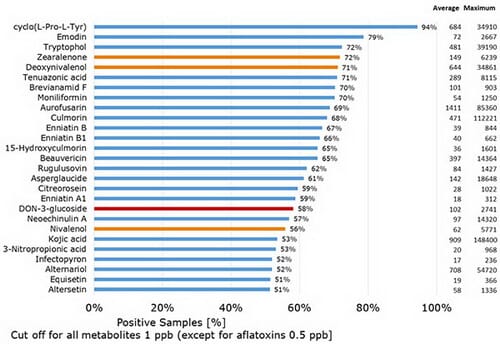Studies focusing on this class of mycotoxins are still quite low in number: an extensive review published in 2015 showed that among all mycotoxin-related studies, only 7% were directed towards emerging mycotoxins.
Emerging mycotoxins in a nutshell
The most relevant and frequently occurring emerging mycotoxins are fusarium toxins. Fusarium have been addressed as the most prevalent fungi that infect agricultural commodities; they can produce a broad array of mycotoxins and secondary metabolites. Fusarium emerging mycotoxins include enniatins (ENNs), beauvericin (BEA), moniliformin (MON) and fusaproliferin (FUS).
Enniatins are known for their antimicrobial, insecticide and antifungal proprieties. These toxins might have herbicide effects as well. The mechanism of action of enniatins is directed towards cellular membrane transport proteins that are inhibited by the toxin. Toxicity of enniatins is particularly severe towards mitochondria. These organelles are a vital components of living beings, are responsible for respiration in the cell, producing most of the adenosine triphosphate (ATP) required for energy transfer. Enniatins do seem to be effectively degraded in animal intestinal systems but further research is required.
Beauvericin shows strong antimicrobial activity towards a broad spectrum of bacteria, with no distinction between Gram-positive and Gram-negative. This toxin also shows cytotoxic, apoptotic and immunosuppressive activity. Beauvericin acts on the cellular membranes increasing the permeability and disrupting the cellular homeostasis.
Although moniliformin shows a relatively lower toxicity compared to enniatins and beauvericin, it has been reported to be toxic towards lymphocytes, skeletomyocytes and cardiomyocytes, with birds and minks being the most sensitive species. The mechanism of action has not been fully elucidated yet, but toxicity towards mitochondria, with a mechanism similar to enniatins, is suspected.
Fusaproliferin has demonstrated toxicity towards human B lymphocytes and some insect cell lines. This emerging mycotoxin also showed teratogenic and pathogenic effects on chicken embryos. In recent years, some studies were conducted using brine shrimp (Artemia salina) as a model organism. The toxin often co-occurs with deacetyl-fusaproliferin, although the toxicity of the latter is much lower compared to fusaproliferin. Studies on the synergistic effects between the two toxins have not be reported so far.
Occurrence
With the increasing sensitivity of analytical methods it became possible to detect a broad array of feed contaminants, including mycotoxins and bacterial secondary metabolites. This brought people and food authorities to be more concerned about the significance of feed contamination, and raised the understanding that having a look at singly occurring metabolites is no longer ideal. LC-MS/MS based methods like the Spectrum 380® used at BIOMIN represent the state of the art in mycotoxin analysis. The method allows the simultaneous detection of more than 380 mycotoxins and secondary metabolites in a single sample. In 2015, an average of 31 different metabolites per sample was detected when the worldwide data are considered. Figure 1 gives an overview of the output generated from an analysis conducted via LC-MS/MS. It is possible to notice that the amount of metabolites found in more than 50% of samples is very high. The frequently occurring mycotoxins zearalenone (ZEN), deoxynivalenol (DON) and nivalenol (NIV) were found in 72%, 71% and 56% of samples respectively. Emerging mycotoxins were also detected in great number, and their distribution was the following: enniatin A1, B and B1 were found in 59%, 66% and 67% of samples respectively. Moniliformin and beauvericin were detected in 70% and 65% of all samples analyzed.

Figure 1: LC-MS/MS multi-mycotoxin analysis conducted with Spectrum 380®. Only mycotoxins and secondary metabolites present in more than 50% of the samples analyzed are included in the graph.
These results surely offer a complete picture of what is happening to feed and food on the field, but more efforts are needed from researchers to better understand this newly discovered array of metabolites present in feed and food.

